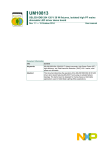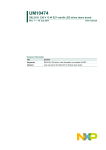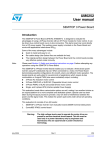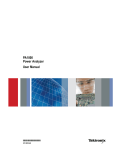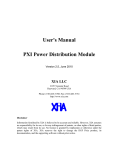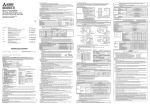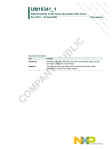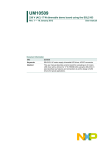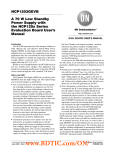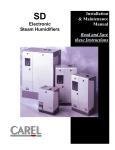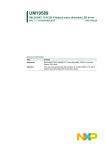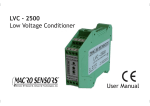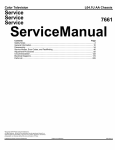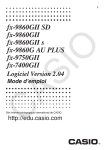Download UM10433 - NXP Semiconductors
Transcript
UM10433 SSL2103 dimmable isolated LED driver demo board Rev. 1 — 9 December 2010 User manual Document information Info Content Keywords SSL2103, LED driver, mains dimmable, constant current, driver, mains supply, AC/DC conversion, user manual. Abstract This is a user manual for the SSL2103 mains dimmable 22 W LED. UM10433 NXP Semiconductors SSL2103 dimmable isolated LED driver demo board Revision history Rev Date Description v.1 20101209 First issue UM10433 User manual All information provided in this document is subject to legal disclaimers. Rev. 1 — 9 December 2010 © NXP B.V. 2010. All rights reserved. 2 of 29 UM10433 NXP Semiconductors SSL2103 dimmable isolated LED driver demo board 1. Introduction The SSL2103 LED driver board is an isolated flyback converter featuring the SSL2103 controller. It is designed for applications with multiple high power LEDs that require high efficiency, galvanic isolation and a safe output voltage. It is mains dimmable for both forward phase (triac) dimmers, and reverse phase (transistor) dimmers. The design is aimed to demonstrate high performance and efficiency. It operates at 70 kHz and produces a regulated output current of up to 800 mA to drive from 6 LEDs to 18 LEDs using a 120 V (AC) or 220 V (AC) input. It can achieve an efficiency of up to 85 % with the help of an external MOSFET transistor. Isolation voltage is 2500 V. 2. Safety warning WARNING Lethal voltage and fire ignition hazard The non-insulated high voltages that are present when operating this product, constitute a risk of electric shock, personal injury, death and/or ignition of fire. This product is intended for evaluation purposes only. It shall be operated in a designated test area by personnel qualified according to local requirements and labor laws to work with non-insulated mains voltages and high-voltage circuits. This product shall never be operated unattended. The board is to be connected to a mains supply so touching the reference board during operation must be avoided at all times. An isolated housing is obligatory when used in uncontrolled, non laboratory environments. Even though the secondary circuit with LED connections has galvanic isolation, this isolation is not according to any regulated norm. Galvanic isolation of the mains phase using a variable transformer is always recommended. These devices can be recognized by the symbols shown in Figure 1. 019aaa690 a. Isolated Fig 1. UM10433 User manual 019aaa691 b. Not Isolated Variac isolation symbols All information provided in this document is subject to legal disclaimers. Rev. 1 — 9 December 2010 © NXP B.V. 2010. All rights reserved. 3 of 29 UM10433 NXP Semiconductors SSL2103 dimmable isolated LED driver demo board 3. Connecting the board Remark: All components referred to in the text can be located on Figure 7 “Board schematic diagram (part 1)” or Figure 8 “Board schematic diagram (part 2)” and connectors can be found on Figure 2 “Board connection diagram”. The board is optimized for either a 230 V (50 Hz) or a 120 V (60 Hz) mains supply. In addition to optimizing the mains voltage, the board is designed to work with multiple high-power LEDs with a total working voltage of between 20 V and 63 V. The output current can be limited using trimmer R68. It is possible to request the delivery of a dedicated LED load that is to be connected to K3. Connector K2 can be used to attach other LED loads. The output voltage is limited to 65 V. It is recommended to connect the LED load to the driver board, before powering up the driver, to avoid potential damage to LEDs due to inrush current as a result of the hot-plugging. K1 K2 L − LED− + LED+ N − LED− K3 LED+ + 019aaa820 Fig 2. Board connection diagram If a galvanically isolated transformer is used, it should be placed between the AC source and the dimmer/demo board. Connect a user defined LED (string) to connector K2 as shown in Figure 2. Note that the anode of the LED (string) is connected to the bottom side of this connector. Remark: When the board is placed in a metal enclosure, the middle pin of connector K1 should be connected to the metal casing for grounding. UM10433 User manual All information provided in this document is subject to legal disclaimers. Rev. 1 — 9 December 2010 © NXP B.V. 2010. All rights reserved. 4 of 29 UM10433 NXP Semiconductors SSL2103 dimmable isolated LED driver demo board 4. Specifications Table 1 provides the specifications for the SSL2103 22 W LED driver Table 1. Specifications Parameter Value Comment AC line input voltage 85 V (AC) to 276 V (AC) board has been optimized for 230 V (AC) or 120 V (AC) ± 10 % variation Output voltage (LED voltage) 20 V (DC) to 63 V (DC) minimum load = 6 LEDs maximum load = 18 LEDs Output voltage protection 65 V (DC) Output power (LED power) 22 W nominal Efficiency > 80 % at Tamb = 25 °C, nominal input voltage, nominal output current, maximum load (18 LEDs), See Figure 13 and Figure 14 Power Factor > 0.9 nominal input voltage, nominal output current, maximum load (18 LEDs), Output current (LED current) 350 mA nominal adjustable with trimmer to 800 mA at minimum load (6 LEDs) Load current accuracy/output voltage dependency <5% nominal output current, See Figure 11 and Figure 12 Load current accuracy/input voltage dependency <5% nominal output current, See Figure 15 and Figure 16 Output current ripple 60 mA nominal output current, maximum load (18 LEDs), See Figure 19 Switching frequency 50 kHz to 90 kHz - See Figure 17 and Figure 18 UM10433 User manual Dimming range 100 % to 0 % for triac dimmer Board dimensions 117 mm × 50 mm × 30 mm L×W×H Operating temperature 0 °C to 85 °C - Isolation voltage 2.5 kV between primary and secondary circuit All information provided in this document is subject to legal disclaimers. Rev. 1 — 9 December 2010 © NXP B.V. 2010. All rights reserved. 5 of 29 UM10433 NXP Semiconductors SSL2103 dimmable isolated LED driver demo board 5. Board photographs 019aab014 Fig 3. Demo board (top) 019aab013 Fig 4. Demo board (bottom) UM10433 User manual All information provided in this document is subject to legal disclaimers. Rev. 1 — 9 December 2010 © NXP B.V. 2010. All rights reserved. 6 of 29 UM10433 NXP Semiconductors SSL2103 dimmable isolated LED driver demo board 6. Dimmers Numerous dimmers have been tested by NXP Semiconductors. The dimming performance of the board may vary as different dimmers have different specifications. Table 2 and Table 3 show the range of dimmers that have been tested and found to be compatible with the board. Table 2. Manufacturer Type Voltage V (AC) Power range (W) Load BERKER 2819 230 60 to 400 incandescent BERKER 2873 230 20 to 500 halogen/incandescent Bush-Jaeger 2250U 230 60 to 600 halogen/incandescent Bush-Jaeger 2200U 230 60 to 400 incandescent LICHTREGLER T10 230 60 to 300 incandescent Gira 0300 230 60 to 400 incandescent Gira 1184 230 60 to 400 incandescent Lutron S-600PH-WH 120 600 halogen/incandescent Lutron MIR-600 120 600 halogen/incandescent Levitron 6602-IW 120 600 incandescent Table 3. UM10433 User manual Triac dimmer selection Transistor dimmer selection Manufacturer Type Voltage V (AC) Power range (W) Load JUNG 243 EX 230 20 to 360 halogen/incandescent JUNG 225 TDE 230 20 to 525 halogen/incandescent BERKER 2874 230 20 to 525 halogen/incandescent BERKER 286710 230 20 to 360 halogen/incandescent Bush-Jaeger 6513U 230 40 to 420 halogen/incandescent Gira 0307 230 20 to 525 halogen/incandescent PEHA 433 HAB 230 20 to 315 halogen/incandescent All information provided in this document is subject to legal disclaimers. Rev. 1 — 9 December 2010 © NXP B.V. 2010. All rights reserved. 7 of 29 UM10433 NXP Semiconductors SSL2103 dimmable isolated LED driver demo board 7. Functional description Remark: All components referred to in the text can be located in Figure 7 “Board schematic diagram (part 1)” or Figure 8 “Board schematic diagram (part 2)”. The IC SSL2103 is the latest extension to the SSL2101/SSL2102 platform and gives designers the flexibility of any power level by controlling external switches. In this application, it controls the flyback converter part and ensures proper dimmer operation. One of these switches controls the flyback input power and stores energy in the transformer TR1. The switch is opened when the duty factor has exceeded the level set by the PWMLIMIT pin, with a maximum of 75 %, or when the voltage on the SOURCE pin exceeds 0.5 V. The energy stored in the transformer is then discharged to D10 and the output capacitors, and finally absorbed by the load. When dimmers are used, the circuit detects the rectified voltage change and reduces the duty cycle and oscillator frequency to reduce the output current. The circuit has a bleeding circuit that drives two external current sinks called bleeders. These are the weak bleeder (pin WB_DRV) and the strong bleeder (pin SB_DRV). When the voltage on both of these pins is below a certain value (typically 52 V) the strong bleeder switch (T4) closes, providing a current path that loads the dimmer during zero voltage crossing. This results in the dimmer timer being reset. When the voltage on either of these pins is above 52 V, and the voltage on the ISENSE pin is above −100 mV, the weak bleeder switch (T3) closes. This provides a current path that loads the dimmer while the converter draws insufficient current to stabilize the dimmer latching. The strong bleeder will always switch but the weak bleeder will not activate until the output power drops below 8 W. This happens when the LEDs are dimmed or when the maximum LED power is tuned to below 8 W. It allows the system to operate with the majority of field installed dimmers. See Figure 5 and Figure 6 that show bleeder drive outputs compared with time, for dimmed and undimmed operations. UM10433 User manual All information provided in this document is subject to legal disclaimers. Rev. 1 — 9 December 2010 © NXP B.V. 2010. All rights reserved. 8 of 29 UM10433 NXP Semiconductors SSL2103 dimmable isolated LED driver demo board WB_DRV SB_DRV Vinput Iinput 019aab016 Fig 5. Dimmed bleeder operation UM10433 User manual All information provided in this document is subject to legal disclaimers. Rev. 1 — 9 December 2010 © NXP B.V. 2010. All rights reserved. 9 of 29 UM10433 NXP Semiconductors SSL2103 dimmable isolated LED driver demo board WB_DRV SB_DRV Vinput Iinput 019aab015 Fig 6. Undimmed bleeder operation 7.1 Bleeder settings The demo board allows the users to disable the bleeders or choose between two configurations of load. This ensures good operation of the dimmer with the converter or a reduction of power losses in the bleeders. • Weak bleeder - jumper (J1-J3) selects a current of 10 mA or 20 mA • Strong bleeder - jumper (J2-J4) selects a current of 25 mA or 60 mA 7.2 Power factor This board is optimized to work with a power factor above 0.9. In order to achieve this, the converter operates at constant ton mode. The output power of the converter is buffered by capacitors C21, C22, C23 and C34. Due to this configuration, the circuit has a resistive input current behavior during undimmed operation (see Figure 6). During dimmed operation however, not only the dimmer latch and hold current must be maintained, but a damper must be added to dampen the inrush current and to dissipate the electrical power stored in the LC filter within the dimmer. An active damping solution has been chosen for the demo board to improve efficiency (see Section 7.5). 7.3 Dimming detection The dimming reference voltage is derived from a non-buffered rectified mains voltage. The dimming range is detected by sensing the average rectified voltage by a resistive divider. The converter duty factor and frequency is set by the voltage on the UM10433 User manual All information provided in this document is subject to legal disclaimers. Rev. 1 — 9 December 2010 © NXP B.V. 2010. All rights reserved. 10 of 29 UM10433 NXP Semiconductors SSL2103 dimmable isolated LED driver demo board BRIGHTNESS and PWMLIMIT pins (see Figure 7 and Figure 8). The peak current through the inductor is reduced by balancing the voltage levels at these two inputs, before the frequency of the converter falls. This eliminates audible noise from the transformer. 7.4 Output voltage and output current Voltage and current regulation is achieved by utilizing two operational amplifiers. Both amplifier outputs are in an or-configuration, to drive the optocoupler U2. This is done via diodes D12 and D13 and the amplifier with the lowest output is dominant. U3B is used for voltage control. The power supply output is sensed through resistive divider R73 and R74 and presented to the inverting input of the operational amplifier. The resistors are selected to provide 2.5 V to pin 5 when the output is at the desired maximum voltage (approximately 62 V in this case). Frequency compensation is provided by R/C network R71 and C28. Current is controlled by sensing the output current through R61 and presenting the sense signal to U3A where it is compared to a trimmed down value from VC1. The output overcurrent threshold level is set by adjusting R68 so that the resultant voltage level presented to pin 3 of U3, with no output load, equals the voltage drop that appears across R61 at the maximum desired current. In this design, the nominal current is set at 350 mA which requires 105 mV of bias at pin 3 under no output load. Frequency compensation (bandwidth) of the current amplifier is set by R66 and C26. 7.5 Active damping - inrush current A damper is required to limit inrush current. Inrush current occurs when the input capacitors encounter fast voltage changes as in the following situations. • when the board is hot-plugged into an AC input source. • when the board is fed from a leading edge phase cut dimmer. There are many ways to perform damping. A single resistor is the cheapest solution but could lead to thermal issues and low efficiency. The damper resistor plays a major factor in the power losses of the system. At low power ratings (< 10 W), a serial resistor is suitable due to acceptable losses. At higher power, an active circuit becomes the preferred solution to achieve high efficiency. The solution applied here utilizes an active damper using a MOSFET transistor (T2). T2 is used to bypass damping resistors R9 and R10 following inrush current. The MOSFET transistor will be ON as long as the current in the circuit is small enough to keep the bipolar transistor T1 from pulling down the gate of MOSFET T2. UM10433 User manual All information provided in this document is subject to legal disclaimers. Rev. 1 — 9 December 2010 © NXP B.V. 2010. All rights reserved. 11 of 29 UM10433 NXP Semiconductors SSL2103 dimmable isolated LED driver demo board 8. Board optimization The following modifications must be carried out in order to meet different customer application requirements. 8.1 Changing the output voltage and LED current Compared to other topologies, a flyback converter has the major advantage that it is suitable for driving a broader range of output voltages. Essentially, changing the turns ratio while maintaining the value of the primary inductance, will shift the output working voltage accordingly. The efficiency of the driver is linked to the output voltage. A lower output voltage increases the transformation ratio and causes higher secondary losses. In practice, a mains dimmable flyback converter has an efficiency of between 80 % for high output voltages (such as 60 V) down to 50 % for low output voltages (such as 3 V). Synchronous rectification might become advisable to reduce losses at low voltages. The NXP TEA1791 can be used for this purpose. For exact calculations of transformer properties and peak current, refer to application note AN10754 and the calculation tool that is provided with it. 8.2 Changing the output ripple current The LED voltage, the LED dynamic resistance and the output capacitor determine the output current ripple. The value of Cout (21-22-23-34) has been chosen to optimize capacitor size with light output. A ripple of ± 25 % results in an expected deterioration of light output < 1 %. The size for the buffer capacitor can be estimated from the following equation: I LED 1 C out = ----------- × -------------------------------------------ΔI 6 × f net × R dynamic (1) Example: For a ripple current of ± 5 % with a mains frequency of 50 Hz and a dynamic resistance of 0.6 Ω, C6 is 20 ÷ (300 × 0.6) = 111 μF. For a ripple current of 25 % and a dynamic resistance of 6 Ω, 4 ÷ (300 × 6) = 2200 μF. Using a series of LEDs, the dynamic resistance of each LED can be added to the total dynamic resistance. 8.3 Improving the power factor The power factor can be increased by reducing the primary capacitance to an absolute minimum to filter the converter. The current then follows the input voltage. This modification has the following consequences: • it is necessary to greatly increase the output capacitance to minimize the output current ripple • because the voltage ripple on the primary capacitors is larger, the peak current through the inductor must increase to have the same output power. This results in higher switching losses that can cause thermal issues. A transformer that can handle the higher current is also required • dimmer support is improved because the current follows the input voltage. However, for some dimmer duty factors additional current bleeding is still necessary UM10433 User manual All information provided in this document is subject to legal disclaimers. Rev. 1 — 9 December 2010 © NXP B.V. 2010. All rights reserved. 12 of 29 UM10433 NXP Semiconductors SSL2103 dimmable isolated LED driver demo board 8.4 Adapting to high power reverse phase (transistor) dimmers. Reverse phase (transistor) dimmers differ in two ways that can be beneficial but can also cause problems with dimming detection: • The negative phase-cut (trailing edge) causes no inrush current when the dimmer triggers. Triac dimmers have a sudden voltage difference over the input leading to a steep charge of the input capacitors. The resulting peak current leads to higher damper dissipation. Because this steep charge is missing, the input capacitors have less stress, and the input circuit is less prone to audible noise. • Transistor dimmers contain active circuitry that requires a load charge during the time that the dimmer is active. The dimensioning of the circuit generating the internal supply voltage inside the dimmer is made critical in order to avoid excessive internal dimmer losses. This results in the remaining voltage drop over the lamp being low enough to reach the load charge. For dimmers such as the Busch-Jaeger 6519U, the minimum lamp load is specified at 40 W which is equivalent to a 1.3 kΩ resistor load at 230 V (AC). Such a load results in highly inefficient operation at low output power levels, since most energy is wasted driving the dimmer instead of producing light. To minimize losses, the weak bleeder on the demo board is set to a maximum current of either 10 mA or 20 mA by using a jumper. The weak bleeder normally only switches on during dimmed operation. The voltage drop with some transistor dimmers is, however, not sufficient to cause full dimming range control (minimum 10 % instead of < 1 %). This is because in this application, the average rectified voltage is used to determine the dimming position. To compensate for the reduced voltage difference, voltage detection can be made more sensitive by replacing R41 with a zener diode, such as the BZV85-C200 for 230 V (AC) or the BZV85-C68 for 120 V (AC). Because of increased sensitivity, the dimming curve is also steeper when using triac dimmers. 8.5 Multiple driver support It is possible to attach multiple converters to a single dimmer. When using triac dimmers the inrush current rises, though not proportionally, to the number of converters. Transistor dimmers are more suitable for use with multiple converters because the dimming range increases with added bleeder action and there is no inrush current. UM10433 User manual All information provided in this document is subject to legal disclaimers. Rev. 1 — 9 December 2010 © NXP B.V. 2010. All rights reserved. 13 of 29 UM10433 NXP Semiconductors SSL2103 dimmable isolated LED driver demo board 9. Board schematic R4 RES1206# 47 kΩ-1/8 W R5 RES1206# 47 kΩ-1/8 W LINE L1 SL-3MCR5.08 F1 1 2 RES2512# F0.5T-NANO2 EARTH 3 2 R2 2X47M0.45C-B82731T NEUTRAL P1 4 3 RES2512# P1 R6 1N4148# 390 kΩ PD1 2 6 1 C1 470P250VXX1Y2.2211W R3 C2 VR1 V71J275V-SIOV.P7 1 150 nF/220 nF 750/390-1/2 W 750/390-1/2 W MKP X2 P1 D3 SMAJ250A/400A D2 + 3 D1 T1 2N2222# 3 n.c. 1 − C3 1 nF/ 50 V 2 4 1 C4 100 nF/ 50 V VBUS A R7 1 kΩ MB6S.T269 R8 S RES2010# 1 Ω-1/4 W BZX84C15.ST23 T2 G R9 RES2512# 220-1/2 W R10 RES2512# 220-1/2 W R11 RES2010# 2.2 Ω/ 8.2 Ω-1/4 W R12 RES2010# RX STD4NK80Z.DK2 D ISENSE R21 R22 R23 R24 R25 R26 RES2512# 820/2.7 kΩ-1/2 W RES2512# 820/2.7 kΩ-1/2 W RES2512# 820/2.7 kΩ-1/2 W RES2512# 820/2.7 kΩ-1/2 W RES2512# 820/2.7 kΩ-1/2 W RES2512# 820/2.7 kΩ-1/2 W B R27 R28 R29 RES2010# 120-1/4 W RES2010# 120-1/4 W RES2010# 120-1/4 W weak bleeder C strong bleeder D7 R52 MMSZ27T1.SD123 RES2010# 220-1/4 W D 4 2 T3 PBHV8140Z.ST223 R36 1 4 2 T4 PBHV8140Z.ST223 R33 1 3.9 KΩ C11 33U35VM.R5P2 4.7 KΩ 3 C12 3 2 2 J1 J3 10 mA 2 20 mA 1 1 2 J2 J4 60 mA 4.7U50VX.1210 W 25 mA 1 1 VBUS C13 TP6 100 nF/50 V R34 1 kΩ R31 130 Ω R35 430 Ω R32 330 Ω SB_DRV 3 1 14 WB_DRV R37 ISENSE ISENSE E R51 2.2 Ω/CMB2027 VCC HVDET 2 13 F R50 DRAIN D 0Ω 9 TP7 68 kΩ/82 kΩ R38 47 kΩ C14 4.7 nF C15 330 pF R39 220 kΩ R44 R41 R42 RES2010# 220 kΩ/470 kΩ1/4 W RES2010# 220 kΩ/470 kΩ1/4 W RC R40 RC2 7 PWR_DRV U1 SSL2103.SO14I 12 33 kΩ/8.2 kΩ R44 VBUS 11 PWMLIMIT SOURCE TP5 5 8 1 kΩ R43 12 kΩ T5 STD4NK80Z.DK2 G 22 Ω S 6 5.9 kΩ BRIGHTNESS R49 TP4 10 AUX VAUX R46 1Ω R47 1Ω R48 1Ω 4 GND C16 4.7U50VX.1210W PWMlimit MH1 MH3.2MM6 MH2 MH3.2MM6 MH3 MH3.2MM6 MH4 MH3.2MM6 019aab012 Fig 7. Board schematic diagram (part 1) UM10433 User manual All information provided in this document is subject to legal disclaimers. Rev. 1 — 9 December 2010 © NXP B.V. 2010. All rights reserved. 14 of 29 UM10433 NXP Semiconductors SSL2103 dimmable isolated LED driver demo board BL3.36Z-6FC 4 R13 RES1206# 120 kΩ 1/8 W C5 C6 150 nF MKP/X2 150 nF MKP/X2 R14 RES1206# 120 kΩ 1/8 W C7 14 2 13 12 3 D5 RS1M.SMA P3 11 4 5 6 D10 MURS340.SMC 1 10 D6 9 5 BAV21WS.SD323 C21 8 6 7 R53 RES1206# 33 kΩ-1/8 W B TR1 C22 TP1 TP2 TP3 C 4 C20 VCI VC1 E R61 C25 SL-2MCR5.08 2 P2 LED− (Cathode) 1 2 D11 BZV55C 5.6 V R66 C26 R65 1 μF/10 V/1210 2.7 kΩ V− 4 P3 P3 VSHUNT U3 V+ 8 3 R67 VC1 75 kΩ C30 R68 1 3 P3 BL3.36Z-6FC C26 100 pF 2 100 nF 4.7 kΩ VC1 3 RES2512# 0.3 Ω-1/2 W 100 nF 180 kΩ BAS16 U2 R64 RES1206# 20 kΩ-1/8 W C32 100 nF 1 P2 C3 CX 3 D13 R75 1.5 kΩ 4 C31 T6 2 PBHV8140Z.ST223 1 C24 100 μF 6.35 V 1210S D PWMLIMIT C34 VSHUNT Y1/WKP 2.2N500VMY1.P12.5M P3 SL-2MCR5.08 R63 RES2010# 2.2 kΩ-1/4 W VAUX F C23 P3 LED+ (Anode) VOUT_A+ 1U100VX.1210 W S1M.SMA 1 220U100VM.R12.5P5I A DC470U100VM40.R16P7.5T 2.2N500VX.1206W NX-SSL2103-1.B.PQ2020 DC470U100VM40.R16P7.5T L2 680U0.36C.WEPD2XLI DC470U100VM40.R16P7.5T D4 R69 1 KΩ 2 SFH6156-3.DS4 C28 R71 R70 47 nF 68 kΩ 240 kΩ VOUT A+ R72 D12 BAS16 V− 4 7 10 kΩ 6 U3 V+ 8 5 R73 VC1 10 KΩ C30 100 nF VC1 Fig 8. R74 10 kΩ 019aab043 Board schematic diagram (part 2) UM10433 User manual All information provided in this document is subject to legal disclaimers. Rev. 1 — 9 December 2010 © NXP B.V. 2010. All rights reserved. 15 of 29 xxxx xxxxxxxxxxxxxxxxxxxxxxxxxxxxxx x xxxxxxxxxxxxxx xxxxxxxxxx xxx xxxxxx xxxxxxxxxxxxxxxxxxxxxxx xxxxxxxxxxxxxxxxxxxxxx xxxxx xxxxxx xx xxxxxxxxxxxxxxxxxxxxxxxxxxxxx xxxxxxxxxxxxxxxxxxxxxx xxxxxxxxxxx xxxxxxx xxxxxxxxxxxxxxxxxxx xxxxxxxxxxxxxxxx xxxxxxxxxxxxxx xxxxxx xx xxxxxxxxxxxxxxxxxxxxxxxxxxxxxxxx xxxxxxxxxxxxxxxxxxxxxxxx xxxxxxx xxxxxxxxxxxxxxxxxxxxxxxxxxxxxxxxxxxxxxxxxxxxxx xxxxxxxxxxx xxxxx x x Reference Part Value Power (W) Tolerance Voltage Package (%) (V) Type Manufacturer SMD 1 P1 connector 3 pin male - - - - SL 5.08/3/90 Weidmuller - 2 P1’ connector 3 pin female - - - - BL 5.08/3 Weidmuller - 3 P3 connector 6 pin female - - - - BL3.36Z Fischer - 4 P2 connector 2 pin male - - - - SL 5.08/2/90 Weidmuller - 5 P2’ connector 2 pin female - - - - BL 5.08/2 Weidmuller - 6 F1 fuse 0.5 AT 1 - - Free 0461.500ER LITTELFUSE Y VR1 varistor - 71 Joules 10 275 Free B72214S0271K101 EPCOS - 8 R2 resistor 390 Ω 1 5 200 2512 - - Y 8* R2 resistor 750 Ω 1 5 200 2512 - - Y 9 R3 resistor 390 Ω 1 5 200 2512 - - Y 9* R3 resistor 750 Ω 1 5 200 2512 - - Y 10 R4 resistor 47 kΩ 0.5 5 200 1206 - - Y 11 R5 resistor 47 kΩ 0.5 5 200 1206 - - Y 12 R6 resistor 390 kΩ 0.25 5 - 0805 - - Y 13 R7 resistor 1 kΩ 0.25 5 - 0805 - - Y 14 R8 resistor 1Ω 0.5 5 200 2010 - - Y 15 R9 resistor 220 Ω 1 5 500 2512 - - Y 16 R10 resistor 220 Ω 1 5 500 2512 - - Y R11 resistor 8.2 Ω 0.5 5 200 2010 - - Y 17* R11 resistor 2.2 Ω 0.5 5 200 2010 - - Y 18 n.c. - - - - - - - - - 19 R13 resistor 120 kΩ 0.5 5 200 1206 - - Y 20 R14 resistor 120 kΩ 0.5 5 200 1206 - - Y 27 R21 resistor 2.7 kΩ 1 5 - 2512 - - Y 27* R21 resistor 820 Ω 1 5 - 2512 - - Y 28 R22 Resistor 2.7 kΩ 1 5 - 2512 - - Y 28* R22 resistor 820 Ω 1 5 - 2512 - - Y 29 R23 resistor 2.7 kΩ 1 5 - 2512 - - Y 29* R23 resistor 820 Ω 1 5 - 2512 - - Y UM10433 16 of 29 © NXP B.V. 2010. All rights reserved. 17 SSL2103 dimmable isolated LED driver demo board Rev. 1 — 9 December 2010 All information provided in this document is subject to legal disclaimers. 7 NXP Semiconductors Part number 10. Bill Of Materials (BOM) UM10433 User manual Table 4. Bill of materials 230 V (AC) and 120 V (AC) Part numbers accompanied with an asterisk (*) are for 120 V (AC). Power is measured in Watts unless otherwise stated. xxxxxxxxxxxxxxxxxxxxx xxxxxxxxxxxxxxxxxxxxxxxxxx xxxxxxx x x x xxxxxxxxxxxxxxxxxxxxxxxxxxxxxx xxxxxxxxxxxxxxxxxxx xx xx xxxxx xxxxxxxxxxxxxxxxxxxxxxxxxxx xxxxxxxxxxxxxxxxxxx xxxxxx xxxxxxxxxxxxxxxxxxxxxxxxxxxxxxxxxxx xxxxxxxxxxxx x x xxxxxxxxxxxxxxxxxxxxx xxxxxxxxxxxxxxxxxxxxxxxxxxxxxx xxxxx xxxxxxxxxxxxxxxxxxxxxxxxxxxxxxxxxxxxxxxxxxxxxxxxxx xxxxxxxx xxxxxxxxxxxxxxxxxxxxxxxxx xxxxxxxxxxxxxxxxxxxx xxx Part number Reference Part Value Power (W) Tolerance Voltage Package (%) (V) Type Manufacturer SMD 30 R24 resistor 2.7 kΩ 1 5 - 2512 - - Y 30* R24 resistor 820 Ω 1 5 - 2512 - - Y 31 R25 resistor 2.7 kΩ 1 5 - 2512 - - Y 31* R25 resistor 820 Ω 1 5 - 2512 - - Y R26 resistor 2.7 kΩ 1 5 - 2512 - - Y 32* R26 resistor 820 Ω 1 5 - 2512 - - Y 33 R27 resistor 120 Ω 0.5 5 - 2010 - - Y 34 R28 resistor 120 Ω 0.5 5 - 2010 - - Y 35 R29 resistor 120 Ω 0.5 5 - 2010 - - Y 36 R31 resistor 130 Ω - 1 - 0805 - - Y 37 R32 resistor 330 Ω - 1 - 0805 - - Y 38 R33 resistor 4.7 kΩ - 5 - 0805 - - Y 39 R34 resistor 1 kΩ - 1 - 0805 - - Y 40 R35 resistor 430 Ω - 1 - 0805 - - Y 41 R36 resistor 3.9 kΩ - 5 - 0805 - - Y 42 R37 resistor 82 kΩ - 1 - 0805 - - Y 42* R37 resistor 68 kΩ - 1 - 0805 - - Y 43 R38 resistor 47 kΩ - 1 - 0805 - - Y 44 R39 resistor 220 kΩ - 1 - 0805 - - Y 45 R40 resistor 5.9 kΩ - 1 - 0805 - - Y 46 R41 resistor 470 kΩ 0.5 5 - 2010 - - Y 46* R41 resistor 220 kΩ 0.5 5 - 2010 - - Y 47 R42 resistor 470 kΩ 0.5 5 - 2010 - - Y 47* R42 resistor 220 kΩ 0.5 5 - 2010 - - Y R43 resistor 12 kΩ - 1 - 0805 - - Y R44 resistor 8.2 kΩ - 1 - 0805 - - Y 50 R45 resistor 1Ω - 1 - 0805 - - Y 51 R46 resistor 1Ω - 1 - 0805 - - Y 52 R47 resistor 1Ω - 1 - 0805 - - Y UM10433 17 of 29 © NXP B.V. 2010. All rights reserved. 48 49 SSL2103 dimmable isolated LED driver demo board Rev. 1 — 9 December 2010 All information provided in this document is subject to legal disclaimers. 32 NXP Semiconductors UM10433 User manual Table 4. Bill of materials 230 V (AC) and 120 V (AC) …continued Part numbers accompanied with an asterisk (*) are for 120 V (AC). Power is measured in Watts unless otherwise stated. xxxxxxxxxxxxxxxxxxxxx xxxxxxxxxxxxxxxxxxxxxxxxxx xxxxxxx x x x xxxxxxxxxxxxxxxxxxxxxxxxxxxxxx xxxxxxxxxxxxxxxxxxx xx xx xxxxx xxxxxxxxxxxxxxxxxxxxxxxxxxx xxxxxxxxxxxxxxxxxxx xxxxxx xxxxxxxxxxxxxxxxxxxxxxxxxxxxxxxxxxx xxxxxxxxxxxx x x xxxxxxxxxxxxxxxxxxxxx xxxxxxxxxxxxxxxxxxxxxxxxxxxxxx xxxxx xxxxxxxxxxxxxxxxxxxxxxxxxxxxxxxxxxxxxxxxxxxxxxxxxx xxxxxxxx xxxxxxxxxxxxxxxxxxxxxxxxx xxxxxxxxxxxxxxxxxxxx xxx Part number Reference Part Value Power (W) Tolerance Voltage Package (%) (V) Type Manufacturer SMD R48 resistor 1Ω - 1 - 0805 - - Y 54 R49 resistor 22 Ω - 5 - 0805 - - Y 55 R50 resistor 0 unit - 5 - 0805 - - Y 56 R51 resistor 2.2 Ω - 5 - melf CMB02070 VISHAY Y 57 R52 resistor 220 Ω - 5 - 2010 - - Y 58 R53 resistor 33 kΩ - 5 - 0805 - - Y 59 R61 resistor 0.3 Ω - 1 - 2512 - - Y 60 R63 resistor 2.2 KΩ - 1 - 0805 - - Y 61 R64 resistor 20 KΩ - 1 - 0805 - - Y 62 R65 resistor 2.7 KΩ - 1 - 0805 - - Y 63 R66 resistor 180 KΩ - 1 - 0805 - - Y 64 R67 resistor 75 KΩ - 1 - 0805 - - Y 65 R68 trimmer 5 kΩ - 10 - - 10 turns VISHAY - 66 R69 resistor 1 kΩ - 1 - 0805 - - Y 67 R70 resistor 240 KΩ - 1 - 0805 - - Y 68 R71 resistor 68 kΩ 1 - 0805 - - Y - R72 resistor 10 kΩ - 1 - 0805 - - Y R73 resistor 10 kΩ - 1 - 0805 - - Y 71 R74 resistor 10 kΩ - 1 - 0805 - - Y 72 R75 resistor 1.5 kΩ - 1 - 0805 - - Y 73 C1 capacitor 470 pF - 15 250 2211 GA352QR7GF471KW01L Murata Y 74 C2 capacitor 220 nF - 20 275 Poly BFC233922224 VISHAY - 74* C2 capacitor 150 nF - 20 305 Poly B32923C3154M Epcos - 75 C3 capacitor 1 nF - 10 50 0805 - - Y 76 C4 capacitor 100 nF - 10 50 0805 - - Y 77 C5 capacitor 150 nF - 20 305 Poly B32923C3154M Epcos - 78 C6 capacitor 150 nF - 20 305 Poly B32923C3154M Epcos - 79 C7 capacitor 2.2 nF - 10 200 1206 - - Y 80 C11 capacitor 33 μF - 20 35 radial - - - UM10433 18 of 29 © NXP B.V. 2010. All rights reserved. 69 70 SSL2103 dimmable isolated LED driver demo board Rev. 1 — 9 December 2010 All information provided in this document is subject to legal disclaimers. 53 NXP Semiconductors UM10433 User manual Table 4. Bill of materials 230 V (AC) and 120 V (AC) …continued Part numbers accompanied with an asterisk (*) are for 120 V (AC). Power is measured in Watts unless otherwise stated. xxxxxxxxxxxxxxxxxxxxx xxxxxxxxxxxxxxxxxxxxxxxxxx xxxxxxx x x x xxxxxxxxxxxxxxxxxxxxxxxxxxxxxx xxxxxxxxxxxxxxxxxxx xx xx xxxxx xxxxxxxxxxxxxxxxxxxxxxxxxxx xxxxxxxxxxxxxxxxxxx xxxxxx xxxxxxxxxxxxxxxxxxxxxxxxxxxxxxxxxxx xxxxxxxxxxxx x x xxxxxxxxxxxxxxxxxxxxx xxxxxxxxxxxxxxxxxxxxxxxxxxxxxx xxxxx xxxxxxxxxxxxxxxxxxxxxxxxxxxxxxxxxxxxxxxxxxxxxxxxxx xxxxxxxx xxxxxxxxxxxxxxxxxxxxxxxxx xxxxxxxxxxxxxxxxxxxx xxx Part number Reference Part Value Power (W) Tolerance Voltage Package (%) (V) Type Manufacturer SMD 81 C12 capacitor 4.7 μF - 10 50 1210 - - Y 82 C13 capacitor 100 nF - 10 50 0805 - - Y 83 C14 capacitor 4.7 nF - 10 50 0805 - - Y 84 C15 capacitor 330 pF - 10 50 0805 - - Y 85 C16 capacitor 4.7 μF - 10 50 1210 - - Y 86 C20 capacitor 2.2 nF - 20 760 ceramic WKP222MCPEJ0KR VISHAY - 87 C21 capacitor 470 μF - 20 100 radial ECA2AHG471 Panasonic - 88 C22 capacitor 470 μF - 20 100 radial ECA2AHG471 Panasonic - C23 capacitor 470 μF - 20 100 radial ECA2AHG471 Panasonic - C24 capacitor 100 μF - 10 6.3 1210 - - Y 91 C25 capacitor 100 nF - 10 50 0805 - - Y 92 C26 capacitor 1 μF - 10 10 1210 - - Y 93 C27 capacitor 100 pF - 10 50 0805 - - Y 94 C28 capacitor 47 nF - 10 50 0805 - - Y 95 C29 capacitor 100 nF - 10 50 0805 - - Y 96 C30 capacitor 100 nF - 10 50 0805 - - Y 97 C31 capacitor 1 μF - 10 100 1210 - - Y 98 C32 capacitor 100 nF - 10 50 0805 - - Y 99 C34 capacitor 220 μF - 20 100 radial ECA2AHG221 Panasonic - 100 L1 inductor 47 mH - - - - B82731T2451A020 EPCOS - L2 inductor 680 μH - - - - 744776268 Wurth Y TR1 transformer - - - 220 PQ2020 N87/3F3 - - 102* TR1 transformer - - - 110 PQ2020 N87/3F3 - - 103 PD1 rectifier bridge 0.5 A - - - TO269AA MB6S VISHAY Y 104 D1 diode 15 V 0.25 5 15 SOT23 BZX8-C15 NXP Y 105 D2 diode signal 0.5 - 75 Melf LS4148 Reactron Y 106 D3 diode 400 V 400 5 400 DO-214AC SMAJ400A LITTLEFUSE Y 106* D3 diode 250 V 400 5 250 DO-214AC SMAJ250A LITTLEFUSE Y 107 D4 diode 1A - - 1000 SMA Fairchild Y UM10433 19 of 29 © NXP B.V. 2010. All rights reserved. 101 102 SSL2103 dimmable isolated LED driver demo board Rev. 1 — 9 December 2010 All information provided in this document is subject to legal disclaimers. 89 90 RS1M NXP Semiconductors UM10433 User manual Table 4. Bill of materials 230 V (AC) and 120 V (AC) …continued Part numbers accompanied with an asterisk (*) are for 120 V (AC). Power is measured in Watts unless otherwise stated. xxxxxxxxxxxxxxxxxxxxx xxxxxxxxxxxxxxxxxxxxxxxxxx xxxxxxx x x x xxxxxxxxxxxxxxxxxxxxxxxxxxxxxx xxxxxxxxxxxxxxxxxxx xx xx xxxxx xxxxxxxxxxxxxxxxxxxxxxxxxxx xxxxxxxxxxxxxxxxxxx xxxxxx xxxxxxxxxxxxxxxxxxxxxxxxxxxxxxxxxxx xxxxxxxxxxxx x x xxxxxxxxxxxxxxxxxxxxx xxxxxxxxxxxxxxxxxxxxxxxxxxxxxx xxxxx xxxxxxxxxxxxxxxxxxxxxxxxxxxxxxxxxxxxxxxxxxxxxxxxxx xxxxxxxx xxxxxxxxxxxxxxxxxxxxxxxxx xxxxxxxxxxxxxxxxxxxx xxx Reference Part Value Power (W) Tolerance Voltage Package (%) (V) Type Manufacturer SMD 108 D5 diode 1A - - 1000 SMA 109 D6 diode 250 mA - - 200 - RS1M Fairchild Y BAV21WS VISHAY Y 110 D7 diode 27 V 0.5 - - SOD123 MMSZ27T1G ON SEMI Y 111 D10 diode 3A - - 400 SMC MURS340 VISHAY Y 112 D11 zener diode 5.6 V - 5 - Melf BZV55--C5V6 NXP Y 113 D12 diode signal 0.25 - 75 SOT23 BAS16 - Y 114 D13 diode signal 0.25 - 75 SOT23 BAS16 - Y 115 T1 transistor NPN 0.25 - 40 SOT23 2N2222 - Y 116 T2 transistor MOS - - 800 DPAK STD4NK80Z ST Y 117 T3 transistor NPN - - 400 SOT223 PBHV8140Z NXP Y 118 T4 transistor NPN - - 400 SOT223 PBHV8140Z NXP Y 119 T5 transistor MOS - - 800 DPAK STD4NK80Z ST Y 120 T6 transistor NPN - - 400 SOT223 PBHV8140Z NXP Y 121 U1 IC controller - - - - SO-14 SSL2103 NXP Y 122 U2 optocoupler - - - 5300 SMD SFH6156 VISHAY Y 123 U3 AOP - - - - SO-8 LMV358 NS Y UM10433 20 of 29 © NXP B.V. 2010. All rights reserved. SSL2103 dimmable isolated LED driver demo board Rev. 1 — 9 December 2010 All information provided in this document is subject to legal disclaimers. Part number NXP Semiconductors UM10433 User manual Table 4. Bill of materials 230 V (AC) and 120 V (AC) …continued Part numbers accompanied with an asterisk (*) are for 120 V (AC). Power is measured in Watts unless otherwise stated. UM10433 NXP Semiconductors SSL2103 dimmable isolated LED driver demo board 11. Transformer specification Figure 9 is a schematic of the transformer: 1 P1 14 2 13 3 12 11 P2 4 10 5 9 Ns 8 Na 6 7 TR1 019aab048 Fig 9. Transformer schematic 11.1 Winding specification Table 5. Winding specification No. Section Wire Layers Turns Pin Begin End 1 P1 - - - 1 2 2 ISO 0.2 - - - - 3 Ns - - - 7, 8 11, 12 4 ISO 0.2 - - - - 5 P2 - - - 3 4 6 ISO 0.2 - - - - 7 Na - - - 6 5 8 ISO 0.2 - - - - 11.2 Electrical characteristics Table 6. Inductance The tolerance is ± 10 %, at 1 A; nominal frequency = 100 kHz; breakdown voltage P1, P2...Ns = 2.5 kV. Section 11.3 Inductance 230 V (AC) 120 V (AC) Primary 875 μH 433 μH Secondary 219 μH 87 μH Auxiliary 79 μH 43 μH Core and bobbin • Core: PQ2020, 3F3/N87 • Bobbin: CPV-PQ20/20-1S-14P-Z UM10433 User manual All information provided in this document is subject to legal disclaimers. Rev. 1 — 9 December 2010 © NXP B.V. 2010. All rights reserved. 21 of 29 UM10433 NXP Semiconductors SSL2103 dimmable isolated LED driver demo board 11.4 Physical dimensions denotes pin#1 0.799' (20.30 mm) 1.29' typ. (32.76 mm) typ. 0.911' (23.13 mm) typ. 0.911' (23.13 mm) max. 0.024' (0.60 mm) dia pin 12 pl 019aab049 Fig 10. Transformer dimensions UM10433 User manual All information provided in this document is subject to legal disclaimers. Rev. 1 — 9 December 2010 © NXP B.V. 2010. All rights reserved. 22 of 29 UM10433 NXP Semiconductors SSL2103 dimmable isolated LED driver demo board 12. Appendix A - Load curves 019aab018 380 Io (mA) 370 360 (1) 350 (2) 340 330 18 25 31 37 43 50 Vo (V) 56 (1) 230 V input (2) 120 V input Fig 11. Load current regulation 019aab017 900 Io (mA) 800 (1) 700 (2) 600 500 400 18 25 31 37 43 50 Vo (V) 56 (1) 230 V input (2) 120 V input Fig 12. Maximum output current UM10433 User manual All information provided in this document is subject to legal disclaimers. Rev. 1 — 9 December 2010 © NXP B.V. 2010. All rights reserved. 23 of 29 UM10433 NXP Semiconductors SSL2103 dimmable isolated LED driver demo board 13. Appendix B - Efficiency curves 019aab019 84 η (%) (1) 80 (2) 76 (3) 72 90 100 110 120 130 140 Vline Iout = 350 mA (1) 18 LEDs (2) 12 LEDs (3) 6 LEDs Fig 13. Efficiency curve - 120 V (AC) 019aab021 90 η (%) (1) (2) 80 (3) 70 60 200 220 240 260 Vline Iout = 350 mA (1) 18 LEDs (2) 12 LEDs (3) 6 LEDs Fig 14. Efficiency curve - 230 V (AC) UM10433 User manual All information provided in this document is subject to legal disclaimers. Rev. 1 — 9 December 2010 © NXP B.V. 2010. All rights reserved. 24 of 29 UM10433 NXP Semiconductors SSL2103 dimmable isolated LED driver demo board 14. Appendix C - Input voltage dependency 019aab022 360 Io (mA) 356 352 348 344 340 90 100 110 120 130 140 V (RMS) Vout = 56 V Fig 15. 120 V (AC) Input voltage to output current dependency 019aab020 360 Io (mA) 356 352 348 344 340 190 210 230 250 270 V (RMS) Vout = 56 V Fig 16. 230 V (AC) Input voltage to output current dependency UM10433 User manual All information provided in this document is subject to legal disclaimers. Rev. 1 — 9 December 2010 © NXP B.V. 2010. All rights reserved. 25 of 29 UM10433 NXP Semiconductors SSL2103 dimmable isolated LED driver demo board 15. Appendix D - Power factor 019aab023 1.0 pf 0.98 0.96 0.94 0.92 90 100 110 120 130 140 V (RMS) Vout = 56 V Iout = 350 mA Fig 17. Power factor 120 V (AC) 019aab024 1.0 pf 0.96 0.92 0.88 0.84 170 190 210 230 250 270 V (RMS) Vout = 56 V Iout = 350 mA Fig 18. Power factor 230 V (AC) UM10433 User manual All information provided in this document is subject to legal disclaimers. Rev. 1 — 9 December 2010 © NXP B.V. 2010. All rights reserved. 26 of 29 UM10433 NXP Semiconductors SSL2103 dimmable isolated LED driver demo board 16. Appendix E - Output ripple current Iout Vout 019aab011 Maximum load = 350 mA Fig 19. Output ripple current 17. References UM10433 User manual [1] AN10952 — SSL2103 dimmable mains LED driver [2] SSL2103 — Data sheet [3] SMPS — IC for dimmable LED lighting All information provided in this document is subject to legal disclaimers. Rev. 1 — 9 December 2010 © NXP B.V. 2010. All rights reserved. 27 of 29 UM10433 NXP Semiconductors SSL2103 dimmable isolated LED driver demo board 18. Legal information 18.1 Definitions Draft — The document is a draft version only. The content is still under internal review and subject to formal approval, which may result in modifications or additions. NXP Semiconductors does not give any representations or warranties as to the accuracy or completeness of information included herein and shall have no liability for the consequences of use of such information. Export control — This document as well as the item(s) described herein may be subject to export control regulations. Export might require a prior authorization from national authorities. 18.2 Disclaimers Limited warranty and liability — Information in this document is believed to be accurate and reliable. However, NXP Semiconductors does not give any representations or warranties, expressed or implied, as to the accuracy or completeness of such information and shall have no liability for the consequences of use of such information. In no event shall NXP Semiconductors be liable for any indirect, incidental, punitive, special or consequential damages (including - without limitation - lost profits, lost savings, business interruption, costs related to the removal or replacement of any products or rework charges) whether or not such damages are based on tort (including negligence), warranty, breach of contract or any other legal theory. Notwithstanding any damages that customer might incur for any reason whatsoever, NXP Semiconductors’ aggregate and cumulative liability towards customer for the products described herein shall be limited in accordance with the Terms and conditions of commercial sale of NXP Semiconductors. Right to make changes — NXP Semiconductors reserves the right to make changes to information published in this document, including without limitation specifications and product descriptions, at any time and without notice. This document supersedes and replaces all information supplied prior to the publication hereof. Suitability for use — NXP Semiconductors products are not designed, authorized or warranted to be suitable for use in life support, life-critical or safety-critical systems or equipment, nor in applications where failure or malfunction of an NXP Semiconductors product can reasonably be expected to result in personal injury, death or severe property or environmental damage. NXP Semiconductors accepts no liability for inclusion and/or use of NXP Semiconductors products in such equipment or applications and therefore such inclusion and/or use is at the customer’s own risk. Applications — Applications that are described herein for any of these products are for illustrative purposes only. NXP Semiconductors makes no representation or warranty that such applications will be suitable for the specified use without further testing or modification. Customers are responsible for the design and operation of their applications and products using NXP Semiconductors products, and NXP Semiconductors accepts no liability for any assistance with applications or customer product design. It is customer’s sole responsibility to determine whether the NXP Semiconductors product is suitable and fit for the customer’s applications and products planned, as well as for the planned application and use of customer’s third party customer(s). Customers should provide appropriate design and operating safeguards to minimize the risks associated with their applications and products. UM10433 User manual NXP Semiconductors does not accept any liability related to any default, damage, costs or problem which is based on any weakness or default in the customer’s applications or products, or the application or use by customer’s third party customer(s). Customer is responsible for doing all necessary testing for the customer’s applications and products using NXP Semiconductors products in order to avoid a default of the applications and the products or of the application or use by customer’s third party customer(s). NXP does not accept any liability in this respect. Evaluation products — This product is provided on an “as is” and “with all faults” basis for evaluation purposes only. NXP Semiconductors, its affiliates and their suppliers expressly disclaim all warranties, whether express, implied or statutory, including but not limited to the implied warranties of non-infringement, merchantability and fitness for a particular purpose. The entire risk as to the quality, or arising out of the use or performance, of this product remains with customer. In no event shall NXP Semiconductors, its affiliates or their suppliers be liable to customer for any special, indirect, consequential, punitive or incidental damages (including without limitation damages for loss of business, business interruption, loss of use, loss of data or information, and the like) arising out the use of or inability to use the product, whether or not based on tort (including negligence), strict liability, breach of contract, breach of warranty or any other theory, even if advised of the possibility of such damages. Notwithstanding any damages that customer might incur for any reason whatsoever (including without limitation, all damages referenced above and all direct or general damages), the entire liability of NXP Semiconductors, its affiliates and their suppliers and customer’s exclusive remedy for all of the foregoing shall be limited to actual damages incurred by customer based on reasonable reliance up to the greater of the amount actually paid by customer for the product or five dollars (US$5.00). The foregoing limitations, exclusions and disclaimers shall apply to the maximum extent permitted by applicable law, even if any remedy fails of its essential purpose. Safety of high-voltage evaluation products — The non-insulated high voltages that are present when operating this product, constitute a risk of electric shock, personal injury, death and/or ignition of fire. This product is intended for evaluation purposes only. It shall be operated in a designated test area by personnel that is qualified according to local requirements and labor laws to work with non-insulated mains voltages and high-voltage circuits. The product does not comply with IEC 60950 based national or regional safety standards. NXP Semiconductors does not accept any liability for damages incurred due to inappropriate use of this product or related to non-insulated high voltages. Any use of this product is at customer’s own risk and liability. The customer shall fully indemnify and hold harmless NXP Semiconductors from any liability, damages and claims resulting from the use of the product. 18.3 Trademarks Notice: All referenced brands, product names, service names and trademarks are the property of their respective owners. All information provided in this document is subject to legal disclaimers. Rev. 1 — 9 December 2010 © NXP B.V. 2010. All rights reserved. 28 of 29 UM10433 NXP Semiconductors SSL2103 dimmable isolated LED driver demo board 19. Contents 1 2 3 4 5 6 7 7.1 7.2 7.3 7.4 7.5 8 8.1 8.2 8.3 8.4 8.5 9 10 11 11.1 11.2 11.3 11.4 12 13 14 15 16 17 18 18.1 18.2 18.3 19 Introduction . . . . . . . . . . . . . . . . . . . . . . . . . . . . 3 Safety warning . . . . . . . . . . . . . . . . . . . . . . . . . . 3 Connecting the board . . . . . . . . . . . . . . . . . . . . 4 Specifications. . . . . . . . . . . . . . . . . . . . . . . . . . . 5 Board photographs . . . . . . . . . . . . . . . . . . . . . . 6 Dimmers . . . . . . . . . . . . . . . . . . . . . . . . . . . . . . . 7 Functional description . . . . . . . . . . . . . . . . . . . 8 Bleeder settings . . . . . . . . . . . . . . . . . . . . . . . 10 Power factor . . . . . . . . . . . . . . . . . . . . . . . . . . 10 Dimming detection . . . . . . . . . . . . . . . . . . . . . 10 Output voltage and output current . . . . . . . . . 11 Active damping - inrush current . . . . . . . . . . . 11 Board optimization . . . . . . . . . . . . . . . . . . . . . 12 Changing the output voltage and LED current . . . . . . . . . . . . . . . . . . . . . . . . . . . . . . 12 Changing the output ripple current . . . . . . . . . 12 Improving the power factor . . . . . . . . . . . . . . . 12 Adapting to high power reverse phase (transistor) dimmers.. . . . . . . . . . . . . . . . . . . . 13 Multiple driver support . . . . . . . . . . . . . . . . . . 13 Board schematic . . . . . . . . . . . . . . . . . . . . . . . 14 Bill Of Materials (BOM) . . . . . . . . . . . . . . . . . . 16 Transformer specification . . . . . . . . . . . . . . . . 21 Winding specification . . . . . . . . . . . . . . . . . . . 21 Electrical characteristics . . . . . . . . . . . . . . . . 21 Core and bobbin . . . . . . . . . . . . . . . . . . . . . . 21 Physical dimensions . . . . . . . . . . . . . . . . . . . . 22 Appendix A - Load curves. . . . . . . . . . . . . . . . 23 Appendix B - Efficiency curves . . . . . . . . . . . 24 Appendix C - Input voltage dependency . . . . 25 Appendix D - Power factor . . . . . . . . . . . . . . . 26 Appendix E - Output ripple current . . . . . . . . 27 References . . . . . . . . . . . . . . . . . . . . . . . . . . . . 27 Legal information. . . . . . . . . . . . . . . . . . . . . . . 28 Definitions . . . . . . . . . . . . . . . . . . . . . . . . . . . . 28 Disclaimers . . . . . . . . . . . . . . . . . . . . . . . . . . . 28 Trademarks. . . . . . . . . . . . . . . . . . . . . . . . . . . 28 Contents . . . . . . . . . . . . . . . . . . . . . . . . . . . . . . 29 Please be aware that important notices concerning this document and the product(s) described herein, have been included in section ‘Legal information’. © NXP B.V. 2010. All rights reserved. For more information, please visit: http://www.nxp.com For sales office addresses, please send an email to: [email protected] Date of release: 9 December 2010 Document identifier: UM10433





























